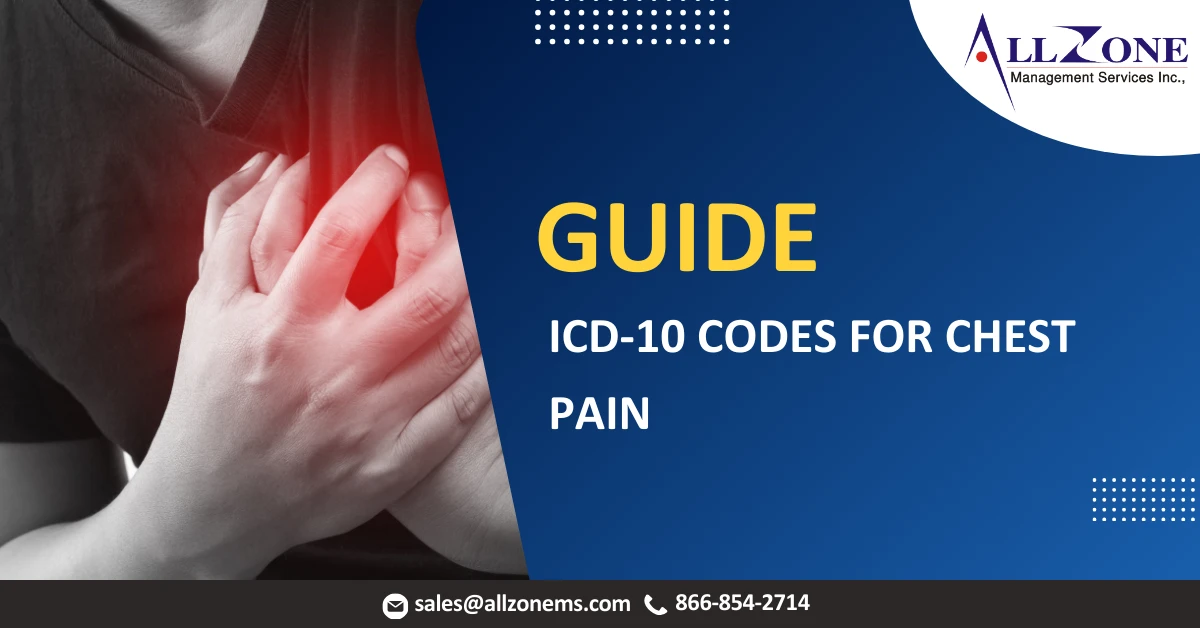Chest pain is a common symptom that can indicate a wide range of underlying medical conditions, from benign issues like muscle strain to life-threatening emergencies such as a heart attack. For healthcare providers and medical billers, accurately documenting and coding chest pain is crucial for proper diagnosis, treatment, and reimbursement. This is where the International Classification of Diseases, Tenth Revision (ICD-10) codes come in. This article will explore the complexities of ICD-10 codes for chest pain, including the most common codes, the importance of modifiers, and how outsourcing medical billing can streamline this process.
Understanding ICD-10 Codes for Chest Pain
The ICD-10 system, maintained by the World Health Organization (WHO), is a standardized classification system used globally to code diagnoses, symptoms, and procedures. For chest pain, a broad symptom, there isn’t just one code. Instead, there’s a family of codes that specify the type, location, and potential cause of the pain. The most general code for unspecified chest pain is R07.9. However, using this code alone is often insufficient for proper billing and may lead to claim denials.
To ensure accuracy, it’s essential to use more specific codes whenever possible. Here are some of the most common ICD-10 codes related to chest pain:
- R07.1 – Chest pain on breathing: This code is used when the pain is directly related to respiratory effort.
- R07.2 – Precordial pain: This refers to pain in the precordium, the area of the chest over the heart.
- R07.4 – Chest pain, unspecified: While similar to R07.9, this code is sometimes used in specific clinical contexts.
The most critical codes, however, are those that link chest pain to a specific diagnosis, such as:
- I20.9 – Angina pectoris, unspecified: This is used for chest pain caused by reduced blood flow to the heart, a symptom of coronary artery disease.
- I21.9 – ST elevation (STEMI) myocardial infarction, unspecified: This is a code for a type of heart attack.
- I25.10 – Atherosclerotic heart disease of native coronary artery without angina pectoris: This code is used for patients with coronary artery disease but who are not currently experiencing angina.
- K21.9 – Gastroesophageal reflux disease without esophagitis: GERD can cause chest pain that mimics heart-related pain, making this an important code for differential diagnosis.
- M54.6 – Pain in thoracic spine: Musculoskeletal issues can also cause chest pain.
Accurate coding hinges on the physician’s thorough documentation. The more detail provided in the patient’s chart—such as the location, duration, character of the pain (e.g., sharp, dull, crushing), and any associated symptoms—the easier it is for a medical coder to select the most appropriate and specific ICD-10 code.
Common Modifiers Used with Chest Pain Billing
Modifiers are essential in conveying additional details about a procedure or service. In the case of chest pain, modifiers are often used when multiple procedures are performed, when services require special circumstances, or when multiple providers are involved.
Some commonly used modifiers include:
- Modifier 25 – Significant, separately identifiable E/M service by the same physician on the same day as another procedure.
- Modifier 59 – Distinct procedural service, often used when chest pain leads to multiple diagnostic tests performed during one visit.
- Modifier 26 – Professional component, when only the interpretation of a diagnostic test (e.g., ECG or imaging) is billed.
- Modifier TC – Technical component, used for billing the technical services like equipment usage for diagnostic testing.
- Modifier 76 – Repeat procedure by the same physician, applicable when chest pain leads to repeated testing during a short timeframe.
Accurate application of modifiers reduces billing errors, supports medical necessity, and ensures faster reimbursement.
Challenges in Coding and Billing for Chest Pain
Despite the availability of clear ICD-10 codes, billing for chest pain is often challenging due to:
- Unclear Documentation – Providers may document only “chest pain” without specifying location or cause, forcing coders to use unspecified codes.
- High Denial Rates – Because chest pain is a vague symptom, insurers may deny claims if the diagnosis is not linked to a medically necessary test or service.
- Frequent Use of Unspecified Codes – Over-reliance on unspecified codes like R07.9 can flag claims for review, leading to delays.
- Complexity of Modifier Usage – Applying the wrong modifier or missing a necessary modifier can result in claim rejections.
How Allzone Can Help with Chest Pain Billing
As a leading medical billing company, Allzone provides end-to-end revenue cycle management services, including:
- Accurate ICD-10 coding for chest pain and other conditions
- Correct application of CPT codes and modifiers
- Claims submission, follow-up, and denial management
- Regular audits to ensure compliance and accuracy
- Customized outsourcing solutions tailored to each practice
By partnering with Allzone, healthcare providers gain access to a team of certified coders and billing specialists who are committed to reducing claim denials, increasing revenue, and improving efficiency.

